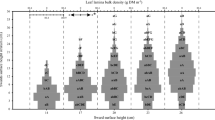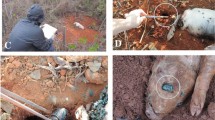Abstract
We investigated the effects of vegetation biomass, crude protein content of consumed forage, age, sex and reproductive status on bite rates in Rocky Mountain bighorn sheep. We expected higher bite rates and vigilance in lactating females with young and higher bite rates in young growing individuals, than in non-reproducing females or rams. Lactating ewes had higher bite rates than yeld ewes and than subadult or adult rams. Subadult rams had higher bite rates than adult rams or yeld ewes. On recently burned grassland in spring, however, rams had a higher bite rate than adult females, while the contrary was true on control plots and on the burned plots in autumn. Bite rates declined for both ewes and rams from April to September and varied from year to year. While rams of different ages had significantly different bite rates, there was no effect of age on bite rates for ewes. There was no correlation between bite rates and available total biomass or biomass of live vegetation, or the numbers of steps taken while foraging for either ewes or rams. Adult rams had a lower vigilance rate than adult ewes, and vigilance decreased with increasing bite rates for all sheep. Bite rates in bighorn sheep vary greatly according to age, season and vegetation structure. An increase in bite rates during the forage growing season may compensate for higher energy demands during lactation and growth. There is a potential trade-off between foraging and vigilance as vigilance decreased with increasing bite rates.




Similar content being viewed by others
References
Arnold GW (1985) Regulation of forage intake. In: Hudson RJ, White, RG (eds) Bioenergetics of wild herbivores. CRC Press, Boca Raton, pp 82–98
Berger J (1991) Pregnancy incentives, predation constraints and habitat shifts: experimental and field evidence for wild bighorn sheep. Anim Behav 41:61–77
Bergman CM, Fryxell JM, Gates CC, Fortin D (2001) Ungulate foraging strategies: energy maximizing or time minimizing? J Anim Ecol 70:289–300
Bleich VC, Bowyer RT, Wehausen JD (1997) Sexual segregation in mountain sheep: resources or predation? Wildl Monogr 134:1–50
Boag, DA, Wishart WD (1982) Distribution and abundance of terrestrial gastropods on a winter range of bighorn sheep in southwestern Alberta. Can J Zool 60:2633–2640
Borjesson DL, Boyce WM, Gardner IA, DeForge J, Lasley B (1996) Pregnancy detection in bighorn sheep (Ovis canadensis) using fecal-based enzyme immunoessay. J Wildl Dis 32:67–74
Bruno E, Lovari S (1989) Foraging behaviour of adult Apennine chamois in relation to the seasonal variation in food supply. Acta Theriol 34–37:513–523
Bunnell FL, Gillingham MP (1985) Foraging behavior: dynamics of dining out. In: Hudson RJ, White, RG (eds) Bioenergetics of wild herbivores. CRC Press, Boca Raton, pp 53–75
Clutton-Brock TH, Harvey PH (1983) The functional significance of variation in body size among mammals. In: Eisenberg JF, Kleiman DG (eds) Advances in the study of mammalian behavior. Am Soc Mammal Spec Publ No.7, pp 632–663
Conradt L (1998) Could asynchrony in activity between the sexes cause intersexual social segregation in ruminants? Proc R Soc Lond B 265:1359–1363
Dehn MM (1990) Vigilance for predators: detection and dilution effects. Behav Ecol Sociobiol 26:337–342
Ferrari C, Rossi, G, Cavani C (1988) Summer food habits and quality of female, kid and subadult Apennine chamois, Rupicapra pyrenaica ornata Neumann, 1899 (Artiodactyla, Bovidae). Z Säugetier 53:170–177
Festa-Bianchet M (1988a) Birthdate and survival in bighorn lambs (Ovis canadensis). J Zool 214:653–661
Festa-Bianchet M (1988b) Nursing behaviour of bighorn sheep: correlates of ewe age, parasitism, lamb age, birthdate and sex. Anim Behav 36:1445–1454
Festa-Bianchet M, Jorgenson JT, King WJ, Smith KG, Wishart WD (1996) The development of sexual dimorphism: seasonal and lifetime mass changes of bighorn sheep. Can J Zool 76:330–342
Frid A (1997) Vigilance by female Dall's sheep: interactions between predation risk factors. Anim Behav 53:799–808
Genstat 5 Committee (1993) Genstat 5 release 3 reference manual. Oxford Science Publications. Clarendon, Oxford
Geist V (1971) Mountain sheep: a study in behaviour and evolution. University of Chicago Press, Chicago
Gross JE, Alkon PU, Demment MW (1996) Nutritional ecology of dimorphic herbivores: digestion and passage rates in Nubian ibex. Oecologia 107:170–178
Gross JE, Hobbs NT, Wunder BA (1993) Independent variables for predicting intake rate of mammalian herbivores: biomass density, plant density, or bite size. Oikos 68:75–81
Gross JE, Demment MW, Alkon PU, Kotzman M (1995) Feeding and chewing behaviours of Nubian ibex: compensation for sex-related differences in body size. Funct Ecol 9:385–393
Hofmann RR (1989) Evolutionary steps of ecophysiological adaptation and diversification of ruminants: a comparative view of their digestive system. Oecologia 78:443–457
Hudson RJ (1985) Body size, energetics, and adaptive radiation. In: Hudson RJ, White, RG (eds) Bioenergetics of wild herbivores. CRC Press, Boca Raton, pp 1–24
Hudson RJ, White RG (1985) Bioenergetics of wild herbivores. CRC Press, Boca Raton
Illius AW, FitzGibbon C (1994) Costs of vigilance in foraging ungulates. Anim Behav 47:481–484
Illius AW, Gordon IJ (1992) Modelling the nutritional ecology of ungulate herbivores: evolution of body size and competitive interactions. Oecologia 89:428–434
Jarman PJ (1974) The social organisation of antelope in relation to their ecology. Behaviour 48:215–267
Lovari S, Rosto G (1985) Feeding rate and social stress of female chamois foraging in groups. In: Lovari S (ed) The biology and management of mountain ungulates. Croom Helm, London, pp 102–105
Martin P, Bateson P (1993) Measuring behaviour. an introductory guide, 2nd edn. Cambridge University Press, Cambridge
McNamara JM (1990) The starvation-predation trade-off and some behavioural and ecological consequences. In: Hughes RN (ed) Behavioural mechanisms of food selection. Springer, Berlin Heidelberg New York, pp 39–58
Murray MG, Brown D (1993) Niche separation of grazing ungulates in the Serengeti: an experimental test. J Anim Ecol 62:380–389
Mysterud A (1998) The relative roles of body size and feeding type on activity time of temperate ruminants. Oecologia 113:442–446
Neuhaus P, Ruckstuhl KE (2002) The link between sexual dimorphism, activity budgets, and group cohesion: the case of the plains zebra (Equus burchelli). Can J Zool 80:1437–1441.
Newman JA, Parsons AJ, Penning PD (1994) A note on the behavioural strategies used by grazing animals to alter their intake rates. Grass Forage Sci 49:1-5
Norusis MJ (1993) SPSS for Windows. SPSS, Chicago
Owen-Smith RN (1988) Megaherbivores. The influence of very large body size on ecology. Cambridge University Press, London
Parsons AJ, Thornley JHM, Newman J, Penning PD (1994) A mechanistic model of some physical determinants of intake rate and diet selection in a two-species temperate grassland sward. Funct Ecol 8:187–204
Pérez-Barberia FJ, Gordon IJ (2001) Relationships between oral morphology and feeding style in the Ungulata: a phylogenetically controlled evaluation. Proc R Soc Lond B 268:1023–1032
Renecker LA, Hudson RJ (1993) Morphology, bioenergetics and resource use. In: Stelfox JB (ed) Hoofed mammals of Alberta. Lone Pine, Edmonton, pp 141–163
Robbins CT (1983) Food resources and their utilization. Academic Press, London
Rubenstein DI (1978) On predation, competition, and the advantage of group living. In: Bateson PPG, Klopfer PH (eds) Perspectives in ethology, vol 1. Plenum, New York, pp 205–231
Ruckstuhl KE (1998) Foraging behaviour and sexual segregation in bighorn sheep. Anim Behav 56:99–106
Ruckstuhl KE (1999) To synchronise or not to synchronise: a dilemma in young bighorn males? Behaviour 136:805–818
Ruckstuhl KE, Festa-Bianchet M (1998) Do reproductive status and lamb gender affect the foraging behavior of bighorn ewes? Ethology 104:941–954
Ruckstuhl KE, Festa-Bianchet M (2001) Group choice by subadult male bighorn sheep: trade-offs between foraging efficiency and predator avoidance. Ethology 107:161–172
Ruckstuhl KE, Neuhaus P (2001) Behavioral synchrony in ibex groups: effects of age, sex and habitat. Behaviour 138: 1033–1046
Ruckstuhl KE, Festa-Bianchet M, Jorgenson JT (2000) Effects of prescribed grassland burns on the forage availability, quality and bighorn sheep use. In: Biennial Symposium of the Northern Wild Sheep and Goat Council, Whitehorse, Yukon, vol 12, pp 11–25
Shipley LA, Gross JE, Spalinger DE, Hobbs TN, Wunder BA (1994) The scaling of intake rate in mammalian herbivores. Am Nat 143:1055–1082
Siegel S, Castellan NJ (1988) Nonparametric statistics for the behavioral sciences, 2nd edn. McGraw-Hill, New York
Spalinger DE, Hobbs NT (1992) Mechanisms of foraging in mammalian herbivores: new models of functional response. Am Nat 140:325–348
Stelfox JB (1993) Hoofed mammals of Alberta. McGraw-Hill, Edmonton
Weckerly FW (1998) Sexual-size dimorphism: influence of mass and mating systems in the most dimorphic mammals. J Mammal 79:33–52
Wilmshurst JF, Fryxell JM, Colucci PE (1999) What constrains daily intake in Thompson's gazelles? Ecology 80:2338–2347
Wrona FJ, Dixon WJ (1991) Group size and predation risk: a field analysis of encounter and dilution effects. Am Nat 137:186–201
Acknowledgements
We thank D. Heynen, R. Fankhauser, S. Ruckstuhl, C. Schütz, S. Rebel, J. Roberge, A. Lüscher, A. Hämmerli, Y. Teuschl and M. -C. Kamke for their help in the field; K. Livingston and B. Wuth (fire specialists, Rocky Mountain House), K. Orich and his crew (Forestry department, Turner Valley) for the prescribed burning; and G. Pomerleau, C. Beaudoin, L.-M. Thériault and B. Mercier for laboratory analyses. Thanks to P. Neuhaus and Sandro Lovari for critical comments on an earlier draft of this manuscript and Tim Coulson, Giacomo Tavecchia and Byron Morgan for statistical advice. Financial support was provided by a Challenge Grant in Biodiversity from the University of Alberta, Department of Biological Sciences and financed through the Alberta Department of Environmental Protection, Fish and Wildlife Trust Fund to K.E. Ruckstuhl; the Alberta Sports, Recreation, Parks and Wildlife Foundation; Alberta Conservation Association; and the Natural Sciences and Engineering Research Council of Canada (NSERC). This manuscript was written while K.E. Ruckstuhl was at the University of Cambridge and financed by an NSERC postdoctoral fellowship and a UK Millennium award. This is a contribution of the Groupe de recherche en écologie, nutrition et énergétique, Département de biologie, Université de Sherbrooke. Our experiments and treatment of animals comply with the current laws of Canada.
Author information
Authors and Affiliations
Corresponding author
Additional information
Communicated by A. Cockburn
Rights and permissions
About this article
Cite this article
Ruckstuhl, K.E., Festa-Bianchet, M. & Jorgenson, J.T. Bite rates in Rocky Mountain bighorn sheep (Ovis canadensis): effects of season, age, sex and reproductive status. Behav Ecol Sociobiol 54, 167–173 (2003). https://doi.org/10.1007/s00265-003-0615-2
Received:
Revised:
Accepted:
Published:
Issue Date:
DOI: https://doi.org/10.1007/s00265-003-0615-2




